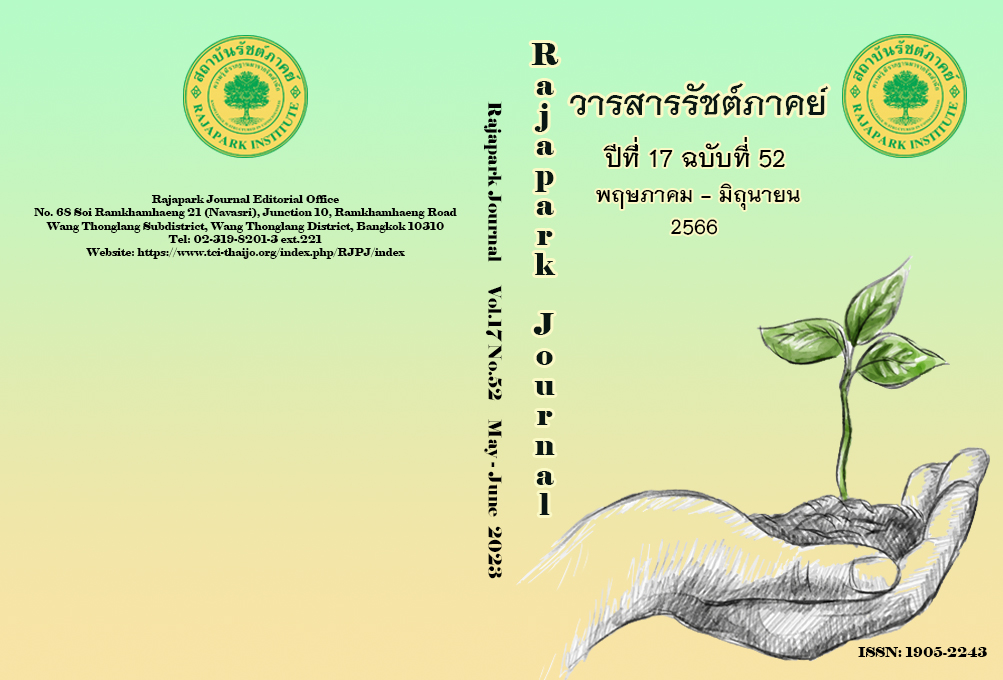Health Communication Management for Non-communicable Diseases
Main Article Content
Abstract
The objectives of this research: 1) To study situations of health communication management for chronic non-communicable diseases in the area of a district in Samut Sakorn, Thailand, and 2) to provide approaches and models for successful participatory health communication management for chronic non-communicable diseases in the area. This research was qualitative research using in-depth interviews and a group discussion consisting of 18 persons purposively selected to collect data. The results showed that the study sites were in urban areas which affected to people in the community to have limited time for participating the health plan process, leading to negative results in terms of goals and motivation for implementing the community health programs. Participatory health communication management for chronic non-communicable diseases in successful communities was based on public health policies. However, local shareholders drafted their own health plans through the community stage and implemented health promotion programs in communities with support from the government. Successful participatory health communication management for chronic non-communicable diseases employed public health policies and community health plans as the foundation for the implementation of community health programs. The guidelines for successful health communication consisted of two factors: 1) Community Health Management is divided into three parts, and 2) In community health operations, encouragement for people in the community to realize, take care of, and strengthen their own health through nine items is needed.
Article Details

This work is licensed under a Creative Commons Attribution-NonCommercial-NoDerivatives 4.0 International License.
Views and opinions appearing in the Journal it is the responsibility of the author of the article, and does not constitute the view and responsibility of the editorial team.
References
Atthanak. C. (2022). Development Model of participation of network partners Health Action Plan Nong Hang Subdistrict Health Promoting Hospital, Kuchinarai District Kalasin Province. Journal of Environmental and Community Health, 7(3), 142-150.
https://he03.tci-thaijo.org/index.php/ech/article/view/898
Bureau of Non-Communicable Diseases, Department of Disease Control, Ministry of Public Health. (2017). Annual Report 2017 Bureau of Non-Communicable Diseases Department of Disease Control. Aksorn Graphic and Design.
Chansawang. W. (2007). Strategies in Health Education and Health Promotion. CDMK.
Department of Disease Control, Ministry of Public Health. (2019). Situation of Operations in Preventing and Controlling Chronic Non-communicable Diseases (NCDs). Ministry of Public Health.
Department of Health Service Support. (2009). The Results of the Evaluation of Communication Plans for the Prevention of Influenza 2009 in the Public Sector. Health Division Publishing.
Kumsri, S., Singsook, C., Reamrimmadun, Y., & Tasiri, P. (2023). Lifestyle and Community Health Systems of People in Bang Lao Subdistrict, Khlong Khuean District, Chachoengsao Province. Journal of Community Development and Life Quality, 10(2), 201-210. https://so02.tci-thaijo.org/index.php/JCDLQ/article/view/254096
Lewin, K. (1936). Principles of Topological Psychology. McGraw-Hill.
Mefalopulos, P. (2003). Theory and Practice of Participatory Communication: The Case of the FAO Project “Communication for Development in Southern Africa”. The University of Texas at Austin. http://hdl.handle.net/2152/776
Mokmula. M. (2016). Integrating the Body of Knowledge on Islamic Religious Provisions for Chronic Diseases. Southern Health Systems Research Institute, Prince of Songkla University.
Pokpermdee, P. (2020). Twenty-Year National Strategic Plan for Public Health (B.E.2561-2580). Journal of Health Science, 29(1), 173-186. https://thaidj.org/index.php/JHS/article/view/8541
Saenchaisuriya, P. et al. (2019). Study Report. Project to Review the Situation and Performance of Non-Communicable Disease Prevention and Control in Thailand 2017-2019. Department of Disease Control, Division of Non-Communicable Diseases, Ministry of Public Health.
Sa-ngrattanapiman, K., & Pattharagornskul, O. (2022) Evaluation of the Non-Communicable Diseases (NCDs) Management System Development, Sakaeo Crown Prince Hospital Network. Journal of Prachomklao College of Nursing, Phetchaburi Province, 5(1), 42-57. https://he01.tci-thaijo.org/index.php/pck/article/view/252127
Servaes, J., Jacobson, T. A., & White, S. A. (1996). Participatory Communication for Social Change. Sage.
Sriphapa. A. (2016). The development of Driving Health Constitution the exercise behaviors in Khokkwang, Bungkla District, Bueng Kan Province[Master's Thesis, Mahasarakham University].
Sthapitanonda. P. (2006). Participatory Communication and Community Development: From Concept to Research Practice in Thai Society. Research Support Fund Office.
Strategy and Planning Division, Ministry of Public Health. (2018). Twenty-Year National Strategic Plan for Public Health (2017-2036) (2nd ed.). Strategy and Planning Division. https://dmsic.moph.go.th/index/detail/7602
World Health Organization. (2020). Non-communicable Diseases: Progress Monitor 2020. https://www.who.int/publications/i/item/ncd-progress-monitor-2020
Yonchoho, N., Chintanadilok, N., & Luangamomlert, S. (2018). The Relationship Between Strategic Implementation and Nursing Organization Performance at Tertiary Level Hospital Under the Ministry of Public Health. Journal of Health Science Research, 12(2), 127-135.


